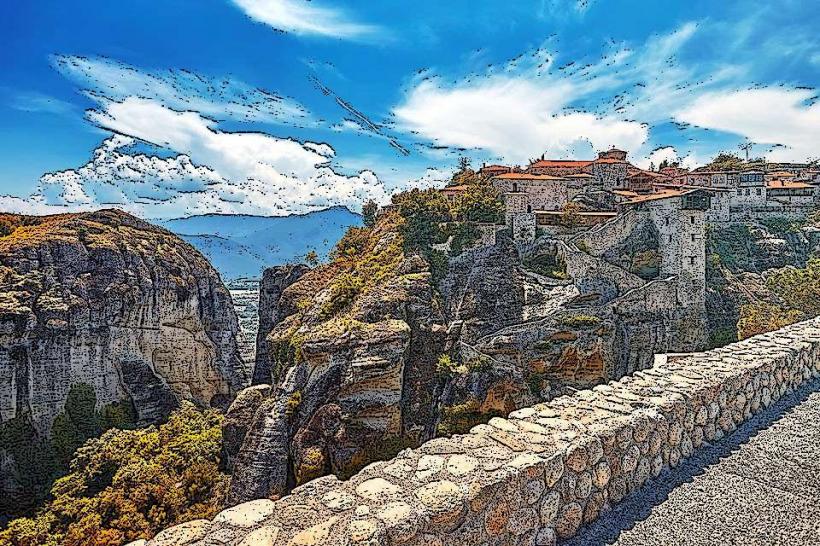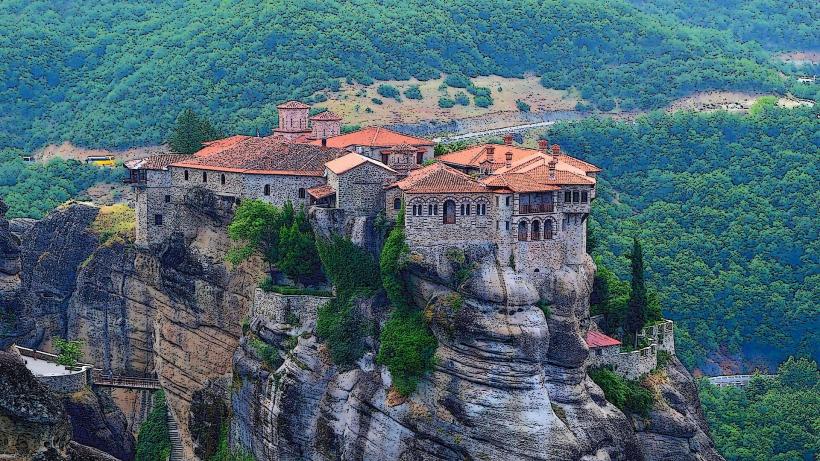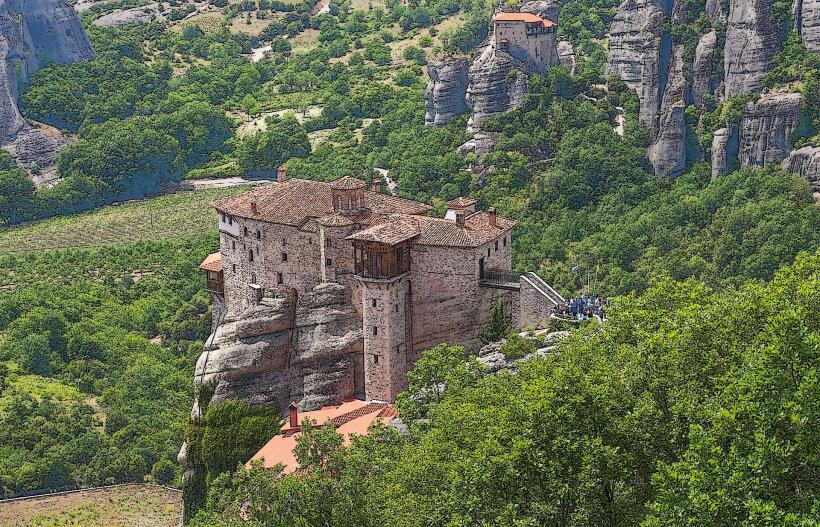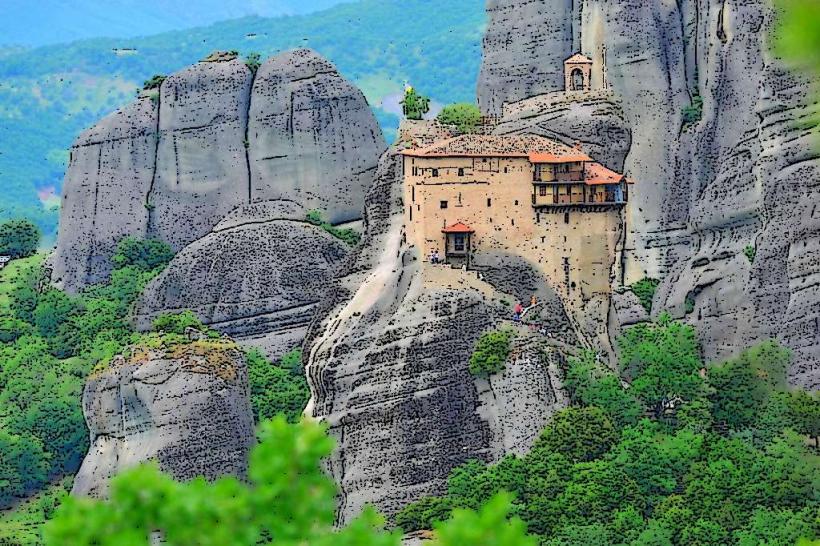Information
Landmark: Monastery of Saint StephenCity: Meteora
Country: Greece
Continent: Europe
The Monastery of St. Stephen (Greek: Μονή Αγίου Στεφάνου) is one of the six active monasteries located in the Meteora region of central Greece, an area known for its breathtaking rock formations and historic monasteries. It is one of the most accessible monasteries in Meteora, as it is located on a lower rock than some of the other monasteries and has been linked to the mainland by a bridge, making it easier to visit. Despite being smaller and more accessible, the Monastery of St. Stephen has a rich history, impressive architecture, and beautiful religious artworks, making it a significant landmark in the Meteora complex.
1. Historical Background
Foundation and Early History: The Monastery of St. Stephen is believed to have been founded around the 14th century, like many of the monasteries in Meteora. Originally, it was a small hermitage for monks who sought a secluded place for spiritual reflection and ascetic life in the rocky landscape of Meteora. The monastery’s exact founding date is uncertain, but records suggest that it was established in the late Byzantine period, during a time when the region was experiencing spiritual revival.
Development: The monastery grew in importance during the 16th century when it was expanded and became a major center of Orthodox monasticism. It was initially part of a network of monasteries in Meteora that served as a refuge for monks and pilgrims seeking peace and solitude. The monastery was named after St. Stephen, a prominent Christian martyr.
Ottoman Period and Decline: Like other Meteora monasteries, St. Stephen's faced a period of decline during the Ottoman occupation of Greece. The monasteries in the region experienced challenges, such as invasions, plundering, and decay. However, St. Stephen's remained active as a place of worship and was maintained despite the difficult circumstances.
Restoration: In the 20th century, the monastery underwent significant restoration, particularly after it was abandoned by its monastic community. Efforts to preserve the architectural and artistic elements of the monastery were successful, and today it is one of the most visited and best-preserved monasteries in Meteora.
2. Architecture and Layout
The Monastery of St. Stephen is built on a smaller rock formation compared to some of the larger Meteora monasteries, which gives it a more accessible and intimate feel. The monastery is a great example of Byzantine monastic architecture, with both religious and defensive features.
Location and Accessibility: Unlike some other Meteora monasteries, St. Stephen's is much more accessible. It is connected to the mainland by a bridge that spans a deep gorge, allowing visitors to walk directly into the monastery without having to climb steep rock formations or use ladders, as was the case in the past. This makes the monastery particularly easy to visit for those with mobility issues or those who prefer a less strenuous climb.
Monastery Complex: The monastery is composed of several key buildings, including:
- Katholikon (Main Church): The katholikon is the focal point of the monastery. It is a small but beautiful Byzantine-style church that is dedicated to St. Stephen. The church is adorned with impressive frescoes that date back to the 16th century and depict scenes from the life of Christ, the Virgin Mary, and various saints. The frescoes are significant examples of post-Byzantine iconography.
- Monastic Cells and Rooms: The monastery includes cells where the monks lived, a refectory (dining hall), and other rooms used for prayer and study. These spaces are relatively simple and modest, in line with the ascetic lifestyle of the monks.
- Defensive Features: While the Monastery of St. Stephen is more accessible than some of the other Meteora monasteries, it still has defensive elements, such as high walls and a fortified gate, which were built to protect the monastery from potential invaders.
Beautiful Gardens: The monastery has a peaceful courtyard with lush greenery, flower gardens, and pathways that provide a tranquil atmosphere for visitors. The gardens enhance the serene environment of the monastery and offer beautiful views of the surrounding Meteora rock formations.
3. Frescoes and Art
The Monastery of St. Stephen is home to a significant collection of frescoes, icons, and other religious artwork, which are a testament to its rich monastic heritage.
- Frescoes in the Katholikon: The main church of the monastery is decorated with frescoes that depict the life of Christ, the Virgin Mary, and scenes from the Last Judgment. The frescoes, though smaller in scale than those in some of the other monasteries in Meteora, are highly detailed and colorful, showcasing the artistic style of the 16th century.
- Iconostasis: The iconostasis, which separates the altar from the rest of the church, is decorated with several icons painted in the traditional Byzantine style. These icons depict scenes from the life of Christ and the Virgin Mary, and they serve both an artistic and religious purpose within the church.
- Other Sacred Artifacts: The monastery also houses liturgical items, manuscripts, and religious objects that reflect the spiritual life of the monks who lived there. These artifacts provide insight into the daily rituals and religious practices of the monastery.
4. Religious and Cultural Significance
Monastic Life: The Monastery of St. Stephen, like the other Meteora monasteries, was founded as a center of monastic life, where monks devoted themselves to prayer, study, and asceticism. The monastery became an important place for the preservation of Orthodox Christianity in a period when the region was under Ottoman rule. St. Stephen’s, like the other monasteries, played a vital role in maintaining religious practices and culture during the difficult years of foreign domination.
Pilgrimage Site: Over the centuries, the monastery became a site of pilgrimage for Orthodox Christians, attracting visitors who sought spiritual solace, divine intervention, or simply a place for reflection. The monastery continues to serve as a place of pilgrimage today.
Cultural Heritage: The monastery is part of the Meteora UNESCO World Heritage Site, recognized for its outstanding natural beauty and cultural significance. The monasteries of Meteora, including St. Stephen’s, have contributed significantly to the preservation of Greek Orthodox monasticism, religious art, and literature during challenging times.
5. Visitor Experience
Accessibility: As one of the more easily accessible monasteries in Meteora, the Monastery of St. Stephen is an ideal starting point for visitors exploring the region. The bridge connecting the monastery to the mainland allows visitors to enter with ease, and the relatively small size of the monastery makes it easy to explore in a short time.
Monastery Grounds: Once inside the monastery, visitors can explore the church with its frescoes and icons, as well as the surrounding gardens and courtyards. The views from the monastery are spectacular, offering panoramic vistas of the Meteora rock formations, the surrounding valley, and nearby villages.
Museum and Exhibits: The monastery houses a small museum where visitors can learn about its history and view a variety of religious artifacts and manuscripts. This offers a more in-depth understanding of the monastic lifestyle and the religious history of the area.
6. Today
Active Monastery: Today, the Monastery of St. Stephen remains an active place of worship, with monks continuing to live and pray in the monastery. Visitors are welcome to attend services and experience the spiritual and peaceful atmosphere of the site.
Tourism: While it is one of the more accessible monasteries in Meteora, the Monastery of St. Stephen still attracts many visitors due to its beautiful setting, rich history, and artistic treasures. It remains a significant stop for those visiting Meteora, whether for religious reasons or to experience the natural beauty of the area.
Conclusion
The Monastery of St. Stephen is a small but significant part of the Meteora complex. With its beautiful frescoes, iconostasis, peaceful gardens, and accessible location, it is one of the most visited monasteries in Meteora. Its history, artistic treasures, and religious importance make it an essential destination for anyone exploring the region. Whether for its spiritual heritage or its breathtaking views, the Monastery of St. Stephen stands as a testament to the enduring legacy of Orthodox monasticism in Greece.






